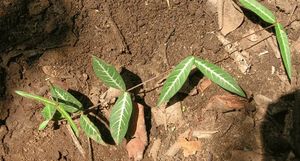Note: This is a project under development. The articles on this wiki are just being initiated and broadly incomplete. You can Help creating new pages.
Hemidesmus indicus - Ananthamoola
Haaluballi (Hemidesmus indicus, Indian sarsaparilla) is a species of plant that is found in South Asia. It is a slender, laticiferous, twining, sometimes prostrate or semi-erect shrub. Roots are woody and aromatic. The stem is numerous, slender, terete, thickened at the nodes. The leaves are opposite, short-petioled, very variable, elliptic-oblong to linear-lanceolate. The flowers are greenish outside, purplish inside, crowded in sub-sessile axillary cymes. It occurs over the greater part of India, from the upper Gangetic plain eastwards to Assam and in some places in central, western and South India.
The root is a substitute for sarsaparilla (the dried root of the tropical species of Smilax, Smilacaceae; in India Smilax aspera L., and Smilax ovalifolia Roxb.).
Traditional uses
Hemidesmus indicus is used to make beverages and also used in traditional medicine. In Ayurveda it goes by the name of Ananthamoola (अनंत मूल), also known locally as Naruneendi or Nannari, Sanskrit meaning: endless root. It is also known as Anant Vel (अनंतवेल)/Maeen Mool (माईन मूळ) in Marathi. In southern states of India (particularly Tamil Nadu), Sarsaparilla roots are called Maahali or Mahani Kizhangu and in its pickled form is also served along with rice dishes. It is also called the False Sarsaparilla. It is administered in the form of powder, infusion or decoction as syrup. It is one of the Rasayana plants of Ayurveda.It is sometimes confused with another Ayurvedic herb called white sariva.
The extracts from the root are used as a coolant and a blood-purifier and also used in many other forms, especially as refreshing syrup with sugar and a dash of lemon (Sharbat), and served at most small refreshment shops in South India.
Health Benefits
According to practitioners of traditional Indian medicine, Ayurveda, this root can be administered in the fourth and ninth month of pregnancy to prevent miscarriage. They also claim its efficacy in treating ulcers, fever, loss of appetite, Gastritis, Anorexia nervosa cough, excessive thirst Menorrhagia, Diarrhea and Diabetes. It is also believed that the extracts from this root help in increasing semen count, purifies blood,neutralizes poisons, works as a diuretic and emetic, and has anti-inflammatory properties. Some experimental studies have displayed the beneficial effect of the extract of this root.
